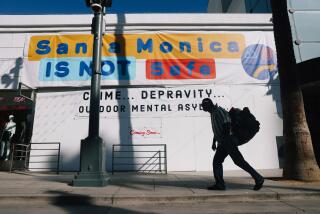City Looks Into Face of the Homeless : Shelter: Complaints about transients prompt Costa Mesa officials to schedule fact-finding meetings with pastors and soup-kitchen volunteers
- Share via
COSTA MESA — Mark usually sleeps on the first bench he finds in the city. He doesn’t have an apartment or a house, so when the sun is coming up, he is just settling down.
“It’s a matter of wasting time until you get tired,” said the 31-year-old New Jersey native, who declined to give his last name as he sat outside the Costa Mesa Job Center last week waiting for work.
Richard Reed, 38, said he’s spent the nights in a local warehouse the past few weeks. But he’s been without home for a few years already, so it’s nothing unusual.
The pair are among the several hundred homeless who walk the streets of Costa Mesa, a city better known for its sprawling shopping malls than its transient population.
In the wake of residents’ complaints about the homeless living in Lions Park, city officials are trying to learn more about these people who live on the streets and sleep in parks and under bridges. City Manager Allan L. Roeder and others are planning to meet this week with local ministers and soup-kitchen volunteers to try to find out who comprises the city’s transient population.
Roeder believes the city will learn much and can benefit by talking to the people who are in contact with the homeless on a daily basis. He plans to report his findings to the City Council on Sept. 19.
More than 10,000 homeless people are believed to live in Orange County. According to an October, 1993, survey of some 1,300 of them, Anaheim and Santa Ana had the most, with Costa Mesa and Orange close behind.
The homeless have been walking the streets of Costa Mesa for years, and they often turn up at the Job Center on Placentia Avenue seeking work. Recently, however, some residents have complained about transients loitering and sleeping at Lions Park. They contend the homeless pose a danger and have asked City Hall to get them out of the park.
Roeder described the problem as a delicate situation and urged a compassionate response.
“Not all the homeless are drug addicts,” he said at a City Council meeting last week. “Not all of them are dangerous. You can’t just label them.”
Resident Sid Soffer likened the identities of the homeless to that of the servicemen in the Tomb of the Unknown Soldier.
“You see the (homeless) all over the place, but you don’t know who they are or where they came from,” he told city officials during the public hearing.
Steven Isenman, senior pastor at the First United Methodist Church in Costa Mesa, said he sees the city’s homeless daily at the church soup kitchen.
There is a great mix of people, he said. Some are mentally ill, others are single men or women running from abusive relationships; still others are people who migrated to California from elsewhere years ago and have fallen on hard times.
Tim Shaw, executive director of the Orange County Homeless Issues Task Force in Irvine, said he had a hard time understanding why residents were complaining.
“It’s a public park,” he said. “If you want privacy, don’t go picnicking at a public park. If you want privacy, have a candlelight dinner at home.
“There’s a lot of fear that goes along with the homeless. There’s this stigma, this stereotype that they’re drug addicts, shifty, lazy, but I know some people who are housed that act like that.”
In Costa Mesa, the Orange Coast Interfaith Shelter offers an alternative to sleeping on the streets: rooms for single men and women and couples for up to three days. Families with children can spend a week or longer.
More than 2,000 people spent nights in the 55 dormitory-style rooms with bunk beds last year, said Valerie Miller, an administrative assistant for the shelter, whose location is not made public. Meals are also provided.
“The help is out there; they just need to find it and go to it,” she said. “But at the same time there are so many homeless that maybe we need more agencies. The number is staggering.”
One of the homeless men who spends time at the park said he would like to see the city construct a building where they could drop off their bags, receive and make telephone calls, take showers and do their laundry in coin-operated machines.
“It wouldn’t even have to have rooms or shelter,” said the middle-aged carpenter, who declined to give his name but said he came to California from Albuquerque in the 1970s in hope of finding better paying work.
“Just so long as somebody was there to watch the bags. That’s what people object to. Our bags. But we don’t have any place to put them.”
Pablo Rosas, also a transient, said he never begs and he isn’t looking for free housing, either. He lives under a bridge that spans the Santa Ana river, collect cans during the day and buys his own food and clothes.
“It’s the police that give me the most trouble,” he said on West 19th Street, his hand resting on the front of a shopping cart.
Mary Ann, 48, frequents the park. Not homeless herself, she calls some of the transients who use the park her friends. She balked at using the term homeless to refer to them.
“The concept of the home is all in the mind,” said Mary Ann, who in August quit her waitress job in Detroit to come to California and lives in an apartment here. “It’s houses that these people don’t have. A place to stay inside. A structure.”
More to Read
Sign up for Essential California
The most important California stories and recommendations in your inbox every morning.
You may occasionally receive promotional content from the Los Angeles Times.













